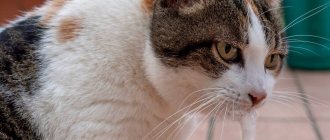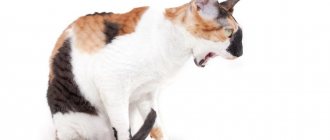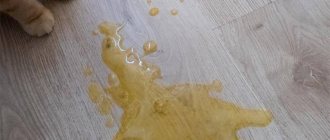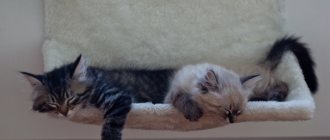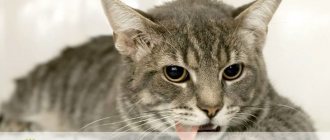Quite often, in the practice of veterinarians, cases of vomiting in domestic cats are recorded. Disturbances in the functioning of the digestive system are almost always accompanied by stool disorders, eruption of gastric contents and painful sensations in the abdominal area.
It is especially alarming for the owner when the cat vomits saliva with white foam. It is necessary to know the main causes of the pathological condition, what causes such vomiting and how to help the animal in the first minutes. After the vomiting stops, it is important to consult a veterinarian for an accurate diagnosis and prescribing adequate treatment with medications.
Causes of vomiting in cats and kittens
Vomiting white foam in cats and kittens can be a protective reaction to the entry of pathogenic bacteria and irritating substances into the digestive system.
This symptom may appear if the animal has eaten something wrong. Pay attention to the vomit. Don't worry if the white foam is a smooth consistency. This may mean a temporary disruption to the digestive system.
Let's look at why a kitten may vomit white foam:
- Overeating, feeding too large pieces of food.
- Hunger. If an animal does not eat for a long enough time, gastric juice begins to irritate the mucous membranes of the digestive organs. As a result, the kitten vomits white foam.
- Too abrupt a transition from one diet to another.
- Feeding food that is harmful to the kitten (fatty, fried, smoked).
- Stale food, ready-made economy class rations.
- Eating inedible objects.
- Poisoning with chemicals (household chemicals, medications, alcohol).
- Consequences of vaccination.
- Inflammatory diseases of the gastrointestinal tract. Symptoms appear immediately after feeding. The kitten first burps, then vomits. If severe diarrhea is added to vomiting, the animal may die.
- Kidney diseases. Vomiting is accompanied by thirst and difficulty urinating.
- Infectious diseases. The most dangerous are feline distemper and panleukopenia, which can be fatal. The kitten vomits white or yellowish foam, attacks occur quite often.
- Respiratory diseases of viral, bacterial etiology. In this case, vomiting is accompanied by a cough, and a small amount of blood is present in the foam.
- Inflammatory diseases of the adrenal glands. The result is a disruption of the normal process of cortisone synthesis, which is accompanied by vomiting, diarrhea, and muscle weakness.
- Worm infestation. Vomiting is caused by toxins that are formed during the life of parasites.
A possible cause of vomiting may be a large amount of fur entering the stomach if the animal licks itself frequently. This process is typical for long-haired animals.
Diagnosis and treatment
A consultation with a veterinarian begins with a medical history. The doctor asks about the pet’s diet, the time of onset of symptoms, and the presence of chronic diseases or infections. A visual examination, palpation of the abdomen and information received from the cat's owner are necessary to make a preliminary diagnosis. Its confirmation is carried out using laboratory diagnostic examination:
- blood, urine, vomit tests;
- Ultrasound of the abdominal organs and kidneys.
After the final diagnosis is made, the sick cat is prescribed a specific therapy regimen. This includes taking medications and restoring lost fluid.
Anti-vomiting medications for cats
Medications are prescribed by a veterinarian after determining the source of the gag reflex. Frequently used tools:
- cerukal and torekan help get rid of nausea and are safe and effective medications with central action;
- famotidine, omeprazole are necessary to reduce the production of hydrochloric acid;
- Heptral, Chofitol, Essentiale belong to the subgroup of hepatoprotectors, recommended for liver pathologies;
- Smecta, Enterosgel are sorbents prescribed for poisoning.
Some animals are prescribed antispasmodics to suppress pain. Therapy is carried out with papaverine, drotaverine, baralgin, platyphylline.
Use of antibiotics
Antibacterial therapy is prescribed for diagnosed inflammatory processes. Additionally, multivitamin complexes and immunostimulants are prescribed. It is carried out:
- ampicillin;
- streptomycin;
- amoxicillin;
- amoxiclav;
- azithromycin.
Medicines are given in tablets, capsules or injectable solutions. The duration of the course and dosage are determined by the attending physician.
For your information! Antibacterial therapy carried out independently provokes serious complications. Antibiotics in the wrong dosage negatively affect the pet’s heart, liver and kidneys and disrupt the normal microflora of the gastrointestinal tract.
Diet food
If pathology occurs, animals are prescribed therapeutic fasting for the first 12 hours. To replenish the loss of water and electrolyte balance, the pet must have free access to water. He should drink without restrictions, but he cannot be forced. Otherwise, the cat will begin to vomit and vomit water.
Subsequently, he is transferred to a specialized medicinal food intended for cats with digestive problems. Preference is given to canned varieties; hard varieties are more difficult to cope with in the affected gastrointestinal tract. The transition to a normal diet occurs gradually and only with the approval of a veterinarian.
Important! During therapy, the animal should be at home, even if it wants to go for a walk.
Free access to water should be maintained throughout the course of treatment
What to do if your cat is vomiting?
So, what should you do if your cat is vomiting white foam? Observe your pet for 24 hours. If your cat vomits but is still acting normally, signs of discomfort may disappear the next day.
If you suspect poisoning or an exacerbation of gastrointestinal diseases, you can try to help the cat by giving it a fasting day. This will restore the functioning of the damaged organ.
The next day, the animal’s condition should return to normal and the vomiting should stop. On the first day after the fasting day, give your cat rice cooked in chicken broth.
Feed your pet more often (up to 6 times a day), in small portions. In subsequent days, reduce the number of feedings and increase the amount of food. Then gradually transition the cat to a regular diet.
If the vomiting was caused by a common stomach upset, give your pet a mint infusion. Pour 1 teaspoon of herb into 1 cup of boiling water and leave until cool. The drink should be warm. Give your cat 1 tablespoon immediately after vomiting.
In what cases should you contact a veterinarian?
The situation becomes more complicated when the pet feels sick and vomits for more than a day, it becomes weak and lethargic and looks sick. If the cat does not go to the toilet or does not allow his stomach to be touched, you should urgently contact a veterinarian.
Other reasons to contact a specialist:
- After a starvation diet, the pet’s condition does not improve; he often vomits (several times an hour).
- If your cat doesn't eat anything all day. In this case, foamy vomit is most likely a sign of a serious illness.
- Vomiting is accompanied by severe thirst, and the cat does not go to the litter box. This indicates kidney pathology.
- Diarrhea, fever (above 38-39 ºС).
- Cramps. The symptom indicates damage to the central nervous system.
- Bloody discharge can be seen in the vomit.
- If your cat regularly spits up fur, his digestive system is not working properly. Your pet may have diseases of the gallbladder, pancreas or rectum.
Vomiting that does not stop for more than a day leads to dehydration. This condition poses a serious threat to life.
The following sign indicates severe dehydration with prolonged vomiting: lift an area of skin with your fingers and release it, it will slowly return to its original shape.
To prevent the death of the animal, you should not self-medicate. Be sure to show your cat to a veterinarian, who will determine the cause of vomiting and provide adequate therapy.
What to do if your cat is vomiting yellow foam?
If a cat vomits yellow foam, it means that bile has entered its stomach. The cause is diseases of the gastrointestinal tract (gastritis, colitis), biliary tract.
Yellowish vomiting in a cat can occur due to calcivirosis, a sudden change in diet, or a foreign body entering the stomach. If your pet has eaten stale or low-quality food, the load on the liver increases. In this case, vomiting of yellow liquid may also occur.
If you suspect that an inedible object or poor-quality food has entered the stomach, you need to provoke vomiting.
Give the animal a saline solution. To prepare it, stir 1 tablespoon of salt in 1 glass of warm water. Drink the solution until the cat begins to vomit.
If vomiting yellow foam was caused by poisoning, give your pet activated charcoal. In case of exacerbations of gastrointestinal diseases, exclude rough, fatty foods from the animal’s diet.
In severe cases, when vomiting with yellow foam was caused by infections, the cat should be taken to the veterinarian. In this case, you need to make droppers with saline solutions and medications.
How to treat a cat
Treatment depends on the type of disease:
- Infectious diseases - treatment at home; if necessary, infusion therapy (droppers) in a hospital setting: antibacterial drugs: Sinulox;
- Tsiprovet.
- Gamavit;
- antibacterial and antimicrobial drugs: Sinulox;
- Papaverine;
- Creon;
- Heptral;
- sorbents: Smecta;
- Milbemax;
- antibiotics: Sinulox;
- Mukaltin;
- Lactusan;
- surgical treatment in a hospital setting;
Vomiting is always a symptom; treatment begins only after its cause has been established by a veterinarian.
Photo gallery: medications for vomiting in cats
Milbemax is prescribed for helminthiasis
Bisacodyl is a laxative that stimulates intestinal motility.
Sinulox helps with bacterial infections
Creon improves digestion
Smecta is prescribed for poisoning as a sorbent

